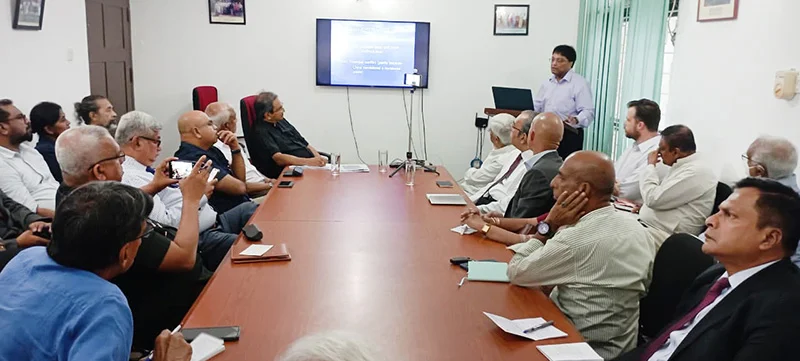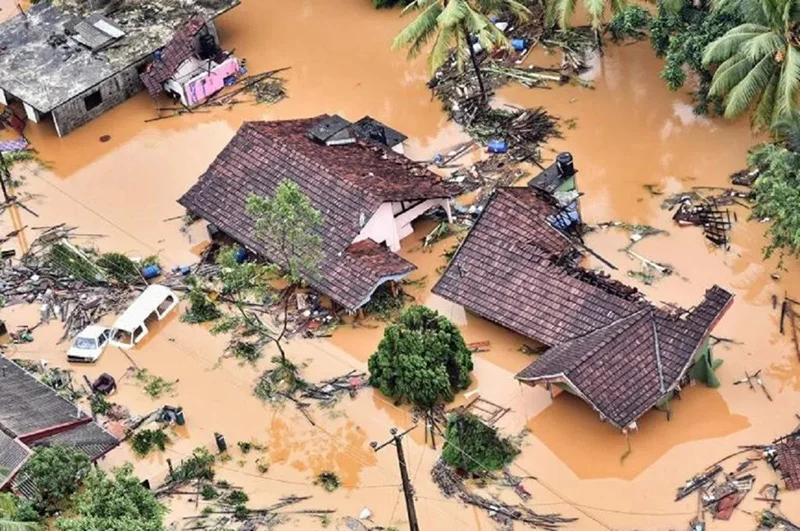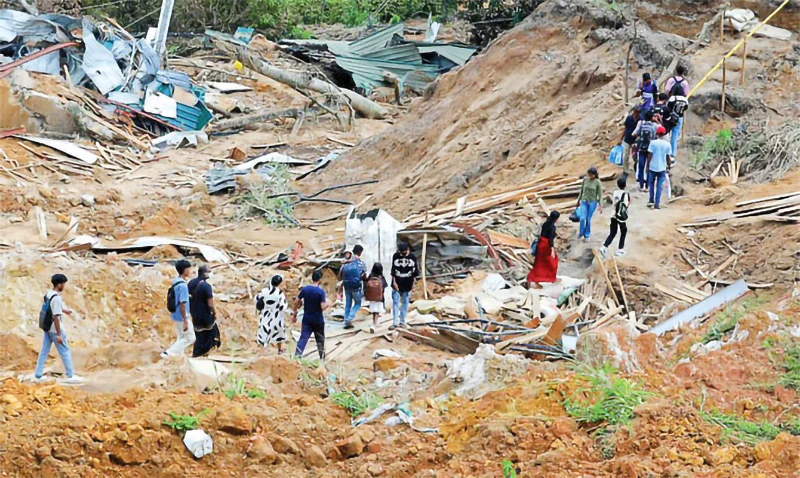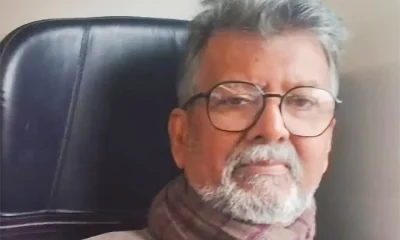Features
Pursuit of Knowledge The purpose of war and conflict

Seeing through the myth:
An analysis By Dr. R.R. de Silva
Man’s greatest feat has been his constant pursuit of knowledge. Unlike other sentient beings in the animal kingdom who do, to some extent, display momentary interest such as when ‘having to gain entry to a container of food’, man has constantly delved on matters of philosophical interest such as where we hail from and where we are headed. The entire story of humanity then oscillates between not knowing and not knowing.
Within these two anthropological milestones, a few men have discovered a formula for achieving great comforts at the expense of other men. Whether these men come from the East or West, whether they are white, oriental or black (although most often white), they have but one objective – global domination, holding no less than the rest of the population in bondage.
The average citizen has been made too busy to see through the myth. Prof. Herbert Macusse in his essay, titled “An essay on liberation,” explains in the very first few pages, how the masses are being provided the necessary training to become obedient workers. These obedient voluntary slaves then become the fodder that fuels the major corporations. Living a life tuned into a rhythm of never-ending obligations, the average citizen is programmed through conditioning to feel the need to seek employment, earn a fair living, pay taxes and keep their heads down while looking after family and friends. This, the citizen is expected to continue until death with no regard to “the virtues of selfishness” that Ayn Rand had so beautifully and succinctly articulated in a book by the same name. The Media first sets the standards that alters your needs into wants. Then using the smallest social unit – “the couple” – the corporation drills into the psyche of man, the need to follow the prescriptive path laid out into modern financial slavery. Unbeknown to many, the trap is set as early on as conception as antenatal care costs commence and continue until, as in some countries, such as Japan, where the parents’ debt is handed down to successive generations.
Have you ever stopped to ask yourselves the questions – Why does school last 12 years, and not nine years or 15 years? Why are the subjects we study the subjects we study? Who chose and defined the syllabus? Why are we forced to attend a registered school? Why are we punished for truancy? Why are we put into tribal uniforms – when uniforms divide and are the instruments of mass identity culling. There is rarely room for individuality among uniformed individuals.
Meanwhile, we experienced to a great extent disruption of life and lifestyle through the grace of the Coronavirus (SARS-CoV -2). Suddenly there was no rush and the most important people around the world spent time at home, washing their hands and hiding behind masks. One cannot but stop to wonder what rush our lives had been until then. People began to experience solitude. Many, could not handle the loneliness, the isolation. Many could not live with the people they had vowed to spend their lives with – till the day death parts them. But others picked up very fast and engaged in gardening, reading, watching movies and if one had sufficient stocks even a booze.
Home cooking became option-less and many despite the shortage of material did experiment. Life and nature, at least for a short while, had a break. But alas, the race is back on with possible truths labelled as conspiracies, governments across the globe acting in concert with numbers that do not appear to reflect the true position.
The Coronavirus has rendered borders closed and time immemorial advice to stay together has made a 180 degree turn with government public health advice now to socially distance ourselves from our normal gregarious selves. The last such epidemic, which may have required face masks and social distancing, took place in 1918 at the tail end of World War 1 – the so called ‘Spanish Flu’. Every war as we know has had a purpose.
In the case of the Covid-19 virus, face masks have rendered us asexual and identity-less minimising any form of human interaction, including sexual attraction. In fact, Public Health guidance forbids social contact through enforced social distancing, in some countries even sex is forbidden. How will this affect our population, especially the young and impressionable? Is this a depopulation attempt? The question should cross your mind! Meanwhile, the situation is pushing people towards a cashless society, digitalising the undigitalised, as more and more people are captured by global digital surveillance systems. Pandemic commotion allowing for uncontrolled data harvesting of vulnerable populations by opportunistic governments colluding with corporates. For instance governments have only hitherto dreamt of citizens volunteering their every whereabout.
The purpose of war has always been commerce. Imperial colonisation was the beginning of the exponential ascent of money and wealth for Europeans, in particular, the British, funded by their Monarchy of German descent. To understand this let us take a look at an article from no less than the BBC – the British Broadcasting Corporation, a media group funded by Her Majesty’s UK Government. Lets review World War 1 because that is what children are most likely to be taught first in world history. I say that the purpose of this war was profiteering as this article by the BBC also suggests. After all the British who are now recognized as the frontline saviours of the world in that war actually have German heritage. This is why the Royal family changed its name to Windsor from Saxe-Coburg-Gotha in 1917.
As the bodies piled up in a war known to have been fought in the trenches, technological advancement saw the development of tanks and aeroplanes develop rapidly to be tested on the field while money was being made. However, not enough people were suspicious of this. Why ? The reason is education – the brainwashing that schools undertake on behalf of their corporate masters whose proxies in legislative bodies around the world prescribe for the average citizenry. To understand this let us dig deeper. According to Elizabeth Bruton of Leeds University, what a lot of people did not see was how the war drove technologies that we are using today like the development of communication technology. The Marconi Company, whose founder was Guglielmo Marconi, led the way with transatlantic broadcasts. They developed voice over wireless. Subsequently Mark Harrison, an economics professor at Warwick University, describes the war as a driver for production. According to this professor, the allied forces/ nations out-produced the Germans. On the other hand businesses, such as shoe-makers and shoe polish producers, had done immensely well according to Terry Chairman the historian at the imperial war museum.
Though seen as the ‘war to end all wars (referring to World War 1)’ The BBC article cites Smedley Butler then a US marine corps Major General who had written in 1935 that “war was far too profitable to be impossible again” points to the profits of steel and weapons manufacturers. Munitions maker du Pont had had the value of its stock rise 374% from 1915 to 1918 and had consequently distributed dividends worth 458% of the value of each share. Shipping companies also paid dividends of 44.7% in 1915 and 47.5% in 1916.
Meanwhile, in the public space media promoted the idea of righteousness and noted that outright profiteering that hurt people would be punished heavily. As a result one article in the Western Daily Press reported in November 1917 that Henry Thompson, a Lincolnshire farmer, was fined £1,800 (about £90,000 in today’s money) for selling potatoes above the maximum allowed price. Does this ring a bell? We certainly do not live too far from that.
Finally, the sweeping meant disconnecting from the other side. For example, “Having a German-sounding name like Schweppes was bad for business and lots of firms made a declaration that they were British through and through. “Lyons Tea sued Liptons for suggesting its board were German. Bovril had it in its adverts that it was all-British and always was British,” he says, while hotels and restaurants stated that they had fired their German and Austrian waiters.
And this then is but a part of World War 1’s commercial interests. Did anything in the above paragraphs sound familiar? Well if it didn’t, read on.
According to a research article on the website of the National Bureau on Economic Research, one researcher points out that when World War I began the US economy was in recession. But a 44-month economic boom ensued from 1914 to 1918, first as Europeans began purchasing US goods for the war and later as the United States itself joined the battle. “The long period of U.S. neutrality made the ultimate conversion of the economy to a wartime basis easier than it otherwise would have been,” The researcher adds that “Real plant and equipment were added, and because they were added in response to demands from other countries already at war, they were added precisely in those sectors where they would be needed once the U.S. entered the war.” Moreover, Entry into the war in 1917 unleashed massive U.S. federal spending which shifted national production from civilian to war goods. Between 1914 and 1918, some three million people were added to the military and half a million to the government. Overall, unemployment declined from 7.9 percent to 1.4 percent in this period, in part because workers were drawn into new manufacturing jobs and because the military draft removed many young men from the civilian labour force.”
Today, a few friends who have had difficulty with their payments on leases for their vehicles have shared with me the institutions from which these leases had been sought had not honoured the so called ‘Moratoriums’ that news telecasts across channels in Sri Lanka have spoken so highly of. Yet in another case several individuals are now having to pay even more so than they had had to. Building owners continued to earn albeit in some cases at discounted rates the rent due for the curfew days of March to June, and now for October and possibly November.
But essentially, people dug into their savings, as their fixed deposit interest diminished and interest rate drops have not been passed on to people’s debt as credit card payments, loan repayments as well as leases pile up with no recognition of the situation.
“Minimisation of life’s volatilities is the secret of long term survival”—Dr. R.R. de Silva 2010
References
https://www.hnb.net/media-center/2020/hnb-group-posts-rs-3-3-bn-pat-for-q1-2020
https://www.ndbbank.com/investor-relations/reports
https://www.combank.net/newweb/en/interim-financials
The writer is a doctor of medicine & invites feedback via email to rds001@protonmail.com
Features
The US-China rivalry and challenges facing the South

 The US-China rivalry could be said to make-up the ‘stuff and substance’ of world politics today but rarely does the international politics watcher and student of the global South in particular get the opportunity of having a balanced and comprehensive evaluation of this crucial relationship. But such a balanced assessment is vitally instrumental in making sense of current world power relations.
The US-China rivalry could be said to make-up the ‘stuff and substance’ of world politics today but rarely does the international politics watcher and student of the global South in particular get the opportunity of having a balanced and comprehensive evaluation of this crucial relationship. But such a balanced assessment is vitally instrumental in making sense of current world power relations.
Thanks to the Regional Centre for Strategic Studies (RCSS), Colombo the above window of opportunity was opened on December 8th for those sections of the public zealously pursuing an understanding of current issues in global politics. The knowledge came via a forum that was conducted at the RCSS titled, ‘The US-China Rivalry and Implications for the Indo-Pacific’, where Professor Neil DeVotta of the Wake Forest University of North Carolina in the US, featured as the speaker.
A widely representative audience was present at the forum, including senior public servants, the diplomatic corps, academics, heads of civil society organizations, senior armed forces personnel and the media. The event was ably managed by the Executive Director of the RCSS, retired ambassador Ravinatha Aryasinha. Following the main presentation a lively Q&A session followed, where many a point of interest was aired and discussed.
While there is no doubt that China is fast catching up with the US with regard to particularly military, economic, scientific and technological capability, Prof. DeVotta helped to balance this standard projection of ‘China’s steady rise’ by pointing to some vital facts about China, the omission of which would amount to the observer having a somewhat uninformed perception of global political realities.
The following are some of the facts about contemporary China that were highlighted by Prof. DeVotta:
* Money is steadily moving out of China and the latter’ s economy is slowing down. In fact the country is in a ‘ Middle Income Trap’. That is, it has reached middle income status but has failed to move to upper income status since then.
* People in marked numbers are moving out of China. It is perhaps little known that some Chinese are seeking to enter the US with a view to living there. The fact is that China’s population too is on the decline.
* Although the private sector is operative in China, there has been an increase in Parastatals; that is, commercial organizations run by the state are also very much in the fore. In fact private enterprises have begun to have ruling Communist Party cells in them.
* China is at its ‘peak power’ but this fact may compel it to act ‘aggressively’ in the international sphere. For instance, it may be compelled to invade Taiwan.
* A Hard Authoritarianism could be said to characterize central power in China today, whereas the expectation in some quarters is that it would shift to a Soft Authoritarian system, as is the case in Singapore.
* China’s influence in the West is greater than it has ever been.
The speaker was equally revelatory about the US today. Just a few of these observations are:
* The US is in a ‘Unipolar Moment’. That is, it is the world’s prime power. Such positions are usually not longstanding but in the case of the US this position has been enjoyed by it for quite a while.
* China is seen by the US as a ‘Revisionist Power’ as opposed to being a ‘Status Quo Power.’ That is China is for changing the world system slowly.
* The US in its latest national security strategy is paying little attention to Soft Power as opposed to Hard Power.
* In terms of this strategy the US would not allow any single country to dominate the Asia-Pacific region.
* The overall tone of this strategy is that the US should step back and allow regional powers to play a greater role in international politics.
* The strategy also holds that the US must improve economic ties with India, but there is very little mention of China in the plan.
Given these observations on the current international situation, a matter of the foremost importance for the economically weakest countries of the South is to figure out how best they could survive materially within it. Today there is no cohesive and vibrant collective organization that could work towards the best interests of the developing world and Dr. DeVotta was more or less correct when he said that the Non-alignment Movement (NAM) has declined.
However, this columnist is of the view that rather being a spent force, NAM was allowed to die out by the South. NAM as an idea could never become extinct as long as economic and material inequalities between North and South exist. Needless to say, this situation is remaining unchanged since the eighties when NAM allowed itself to be a non-entity so to speak in world affairs.
The majority of Southern countries did not do themselves any good by uncritically embracing the ‘market economy’ as a panacea for their ills. As has been proved, this growth paradigm only aggravated the South’s development ills, except for a few states within its fold.
Considering that the US would be preferring regional powers to play a more prominent role in the international economy and given the US’ preference to be a close ally of India, the weakest of the South need to look into the possibility of tying up closely with India and giving the latter a substantive role in advocating the South’s best interests in the councils of the world.
To enable this to happen the South needs to ‘get organized’ once again. The main differences between the past and the present with regard to Southern affairs is that in the past the South had outstanding leaders, such as Jawaharlal Nehru of India, who could doughtily stand up for it. As far as this columnist could ascertain, it is the lack of exceptional leaders that in the main led to the decline of NAM and other South-centred organizations.
Accordingly, an urgent task for the South is to enable the coming into being of exceptional leaders who could work untiringly towards the realization of its just needs, such as economic equity. Meanwhile, Southern countries would do well to, indeed, follow the principles of NAM and relate cordially with all the major powers so as to realizing their best interests.
Features
Sri Lanka and Global Climate Emergency: Lessons of Cyclone Ditwah

Tropical Cyclone Ditwah, which made landfall in Sri Lanka on 28 November 2025, is considered the country’s worst natural disaster since the deadly 2004 tsunami. It intensified the northeast monsoon, bringing torrential rainfall, massive flooding, and 215 severe landslides across seven districts. The cyclone left a trail of destruction, killing nearly 500 people, displacing over a million, destroying homes, roads, and railway lines, and disabling critical infrastructure including 4,000 transmission towers. Total economic losses are estimated at USD 6–7 billion—exceeding the country’s foreign reserves.
The Sri Lankan Armed Forces have led the relief efforts, aided by international partners including India and Pakistan. A Sri Lanka Air Force helicopter crashed in Wennappuwa, killing the pilot and injuring four others, while five Sri Lanka Navy personnel died in Chundikkulam in the north while widening waterways to mitigate flooding. The bravery and sacrifice of the Sri Lankan Armed Forces during this disaster—as in past disasters—continue to be held in high esteem by grateful Sri Lankans.
The Sri Lankan government, however, is facing intense criticism for its handling of Cyclone Ditwah, including failure to heed early warnings available since November 12, a slow and poorly coordinated response, and inadequate communication with the public. Systemic issues—underinvestment in disaster management, failure to activate protocols, bureaucratic neglect, and a lack of coordination among state institutions—are also blamed for avoidable deaths and destruction.
The causes of climate disasters such as Cyclone Ditwah go far beyond disaster preparedness. Faulty policymaking, mismanagement, and decades of unregulated economic development have eroded the island’s natural defenses. As climate scientist Dr. Thasun Amarasinghe notes:
“Sri Lankan wetlands—the nation’s most effective natural flood-control mechanism—have been bulldosed, filled, encroached upon, and sold. Many of these developments were approved despite warnings from environmental scientists, hydrologists, and even state institutions.”
Sri Lanka’s current vulnerabilities also stem from historical deforestation and plantation agriculture associated with colonial-era export development. Forest cover declined from 82% in 1881 to 70% in 1900, and to 54–50% by 1948, when British rule ended. It fell further to 44% in 1954 and to 16.5% by 2019.
Deforestation contributes an estimated 10–12% of global greenhouse gas emissions. Beyond removing a vital carbon sink, it damages water resources, increases runoff and erosion, and heightens flood and landslide risk. Soil-depleting monocrop agriculture further undermines traditional multi-crop systems that regenerate soil fertility, organic matter, and biodiversity.
In Sri Lanka’s Central Highlands, which were battered by Cyclone Ditwah, deforestation and unregulated construction had destabilised mountain slopes. Although high-risk zones prone to floods and landslides had long been identified, residents were not relocated, and construction and urbanisation continued unchecked.
Sri Lanka was the first country in Asia to adopt neoliberal economic policies. With the “Open Economy” reforms of 1977, a capitalist ideology equating human well-being with quantitative growth and material consumption became widespread. Development efforts were rushed, poorly supervised, and frequently approved without proper environmental assessment.
Privatisation and corporate deregulation weakened state oversight. The recent economic crisis and shrinking budgets further eroded environmental and social protections, including the maintenance of drainage networks, reservoirs, and early-warning systems. These forces have converged to make Sri Lanka a victim of a dual climate threat: gradual environmental collapse and sudden-onset disasters.
Sri Lanka: A Climate Victim
Sri Lanka’s carbon emissions remain relatively small but are rising. The impact of climate change on the island, however, is immense. Annual mean air temperature has increased significantly in recent decades (by 0.016 °C annually between 1961 and 1990). Sea-level rise has caused severe coastal erosion—0.30–0.35 meters per year—affecting nearly 55% of the shoreline. The 2004 tsunami demonstrated the extreme vulnerability of low-lying coastal plains to rising seas.
The Cyclone Ditwah catastrophe was neither wholly new nor surprising. In 2015, the Geneva-based Internal Displacement Monitoring Centre (IDMC) identified Sri Lanka as the South Asian country with the highest relative risk of disaster-related displacement: “For every million inhabitants, 15,000 are at risk of being displaced every year.”
IDMC also noted that in 2017 the country experienced seven disaster events—mainly floods and landslides—resulting in 135,000 new displacements and that Sri Lanka “is also at risk for slow-onset impacts such as soil degradation, saltwater intrusion, water scarcity, and crop failure”.
Sri Lanka ranked sixth among countries most affected by extreme weather events in 2018 (Germanwatch) and second in 2019 (Global Climate Risk Index). Given these warnings, Cyclone Ditwah should not have been a surprise. Scientists have repeatedly cautioned that warmer oceans fuel stronger cyclones and warmer air holds more moisture, leading to extreme rainfall. As the Ceylon Today editorial of December 1, 2025 also observed:
“…our monsoons are no longer predictable. Cyclones form faster, hit harder, and linger longer. Rainfall becomes erratic, intense, and destructive. This is not a coincidence; it is a pattern.”
Without urgent action, even more extreme weather events will threaten Sri Lanka’s habitability and physical survival.
A Global Crisis
Extreme weather events—droughts, wildfires, cyclones, and floods—are becoming the global norm. Up to 1.2 billion people could become “climate refugees” by 2050. Global warming is disrupting weather patterns, destabilising ecosystems, and posing severe risks to life on Earth. Indonesia and Thailand were struck by the rare and devastating Tropical Cyclone Senyar in late November 2025, occurring simultaneously with Cyclone Ditwah’s landfall in Sri Lanka.
More than 75% of global greenhouse gas emissions—and nearly 90% of carbon emissions—come from burning coal, oil, and gas, which supply about 80% of the world’s energy. Countries in the Global South, like Sri Lanka, which contribute least to greenhouse gas emissions, are among the most vulnerable to climate devastation. Yet wealthy nations and multilateral institutions, including the World Bank, continue to subsidise fossil fuel exploration and production. Global climate policymaking—including COP 30 in Belém, Brazil, in 2025—has been criticised as ineffectual and dominated by fossil fuel interests.
If the climate is not stabilised, long-term planetary forces beyond human control may be unleashed. Technology and markets are not inherently the problem; rather, the issue lies in the intentions guiding them. The techno-market worldview, which promotes the belief that well-being increases through limitless growth and consumption, has contributed to severe economic inequality and more frequent extreme weather events. The climate crisis, in turn, reflects a profound mismatch between the exponential expansion of a profit-driven global economy and the far slower evolution of human consciousness needed to uphold morality, compassion, generosity and wisdom.
Sri Lanka’s 2025–26 budget, adopted on November 14, 2025—just as Cyclone Ditwah loomed—promised subsidised land and electricity for companies establishing AI data centers in the country.
President Anura Kumara Dissanayake told Parliament: “Don’t come questioning us on why we are giving land this cheap; we have to make these sacrifices.”
Yet Sri Lanka is a highly water-stressed nation, and a growing body of international research shows that AI data centers consume massive amounts of water and electricity, contributing significantly to greenhouse gas emissions.
The failure of the narrow, competitive techno-market approach underscores the need for an ecological and collective framework capable of addressing the deeper roots of this existential crisis—both for Sri Lanka and the world.

A landslide in Sri Lanka (AFP picture)
Ecological and Human Protection
Ecological consciousness demands
recognition that humanity is part of the Earth, not separate from it. Policies to address climate change must be grounded in this understanding, rather than in worldviews that prize infinite growth and technological dominance. Nature has primacy over human-created systems: the natural world does not depend on humanity, while humanity cannot survive without soil, water, air, sunlight, and the Earth’s essential life-support systems.
Although a climate victim today, Sri Lanka is also home to an ancient ecological civilization dating back to the arrival of the Buddhist monk Mahinda Thera in the 3rd century BCE. Upon meeting King Devanampiyatissa, who was out hunting in Mihintale, Mahinda Thera delivered one of the earliest recorded teachings on ecological interdependence and the duty of rulers to protect nature:
“O great King, the birds of the air and the beasts of the forest have as much right to live and move about in any part of this land as thou. The land belongs to the people and all living beings; thou art only its guardian.”
A stone inscription at Mihintale records that the king forbade the killing of animals and the destruction of trees. The Mihintale Wildlife Sanctuary is believed to be the world’s first.
Sri Lanka’s ancient dry-zone irrigation system—maintained over more than a millennium—stands as a marvel of sustainable development. Its network of interconnected reservoirs, canals, and sluices captured monsoon waters, irrigated fields, controlled floods, and even served as a defensive barrier. Floods occurred, but historical records show no disasters comparable in scale, severity, or frequency to those of today. Ancient rulers, including the legendary reservoir-builder King Parākramabāhu, and generations of rice farmers managed their environment with remarkable discipline and ecological wisdom.
The primacy of nature became especially evident when widespread power outages and the collapse of communication networks during Cyclone Ditwah forced people to rely on one another for survival. The disaster ignited spontaneous acts of compassion and solidarity across all communities—men and women, rich and poor, Buddhists, Christians, Muslims, and Hindus. Local and international efforts mobilized to rescue, shelter, feed, and emotionally support those affected. These actions demonstrated a profound human instinct for care and cooperation, often filling vacuums left by formal emergency systems.
Yet spontaneous solidarity alone is insufficient. Sri Lanka urgently needs policies on sustainable development, environmental protection, and climate resilience. These include strict, science-based regulation of construction; protection of forests and wetlands; proper maintenance of reservoirs; and climate-resilient infrastructure. Schools should teach environmental literacy that builds unity and solidarity, rather than controversial and divisive curriculum changes like the planned removal of history and introduction of contested modules on gender and sexuality.
If the IMF and international creditors—especially BlackRock, Sri Lanka’s largest sovereign bondholder, valued at USD 13 trillion—are genuinely concerned about the country’s suffering, could they not cancel at least some of Sri Lanka’s sovereign debt and support its rebuilding efforts? Addressing the climate emergency and the broader existential crisis facing Sri Lanka and the world ultimately requires an evolution in human consciousness guided by morality, compassion, generosity and wisdom. (Courtesy: IPS NEWS)
Dr Asoka Bandarage is the author of Colonialism in Sri Lanka: The Political Economy of the Kandyan Highlands, 1833-1886 (Mouton) Women, Population and Global Crisis: A Politico-Economic Analysis (Zed Books), The Separatist Conflict in Sri Lanka: Terrorism, Ethnicity, Political Economy, ( Routledge), Sustainability and Well-Being: The Middle Path to Environment, Society and the Economy (Palgrave MacMillan) Crisis in Sri Lanka and the World: Colonial and Neoliberal Origins, Ecological and Collective Alternatives (De Gruyter) and numerous other publications. She serves on the Advisory Boards of the Interfaith Moral Action on Climate and Critical Asian Studies.
Features
Cliff and Hank recreate golden era of ‘The Young Ones’

 Cliff Richard and Hank Marvin’s reunion concert at the Riverside Theatre in Perth, Australia, on 01 November, 2025, was a night to remember.
Cliff Richard and Hank Marvin’s reunion concert at the Riverside Theatre in Perth, Australia, on 01 November, 2025, was a night to remember.
The duo, who first performed together in the 1950s as part of The Shadows, brought the house down with their classic hits and effortless chemistry.
The concert, part of Cliff’s ‘Can’t Stop Me Now’ tour, featured iconic songs like ‘Summer Holiday’, ‘The Young Ones’, ‘Bachelor Boy’, ‘Living Doll’ and a powerful rendition of ‘Mistletoe and Wine.’
Cliff, 85, and Hank, with his signature red Fender Stratocaster, proved that their music and friendship are timeless.
According to reports, the moment the lights dimmed and the first chords of ‘Move It’ rang out, the crowd knew they were in for something extraordinary.
Backed by a full band, and surrounded by dazzling visuals, Cliff strode onto the stage in immaculate form – energetic and confident – and when Hank Marvin joined him mid-set, guitar in hand, the audience erupted in applause that shook the hall.
Together they launched into ‘The Young Ones’, their timeless 1961 hit which brought the crowd to its feet, with many in attendance moved to tears.
The audience was treated to a journey through time, with vintage film clips and state-of-the-art visuals adding to the nostalgic atmosphere.
Highlights of the evening included Cliff’s powerful vocals, Hank’s distinctive guitar riffs, and their playful banter on stage.

Cliff posing for The Island photographer … February,
2007
Cliff paused between songs to reflect on their shared journey saying:
“It’s been a lifetime of songs, memories, and friendship. Hank and I started this adventure when we were just boys — and look at us now, still up here making noise!”
As the final chords of ‘Congratulations’ filled the theatre, the crowd rose for a thunderous standing ovation that lasted several minutes.
Cliff waved, Hank gave a humble bow, and, together, they left the stage, arm-in-arm, to the refrain of “We’re the young ones — and we always will be.”
Reviews of the show were glowing, with fans and critics alike praising the duo’s energy, camaraderie, and enduring talent.
Overall, the Cliff Richard and Hank Marvin reunion concert was a truly special experience, celebrating the music and friendship that has captivated audiences for decades.
When Cliff Richard visited Sri Lanka, in February, 2007, I was invited to meet him, in his suite, at a hotel, in Colombo, and I presented him with my music page, which carried his story, and he was impressed.
In return, he personally autographed a souvenir for me … that was Cliff Richard, a truly wonderful human being.
-

 News3 days ago
News3 days agoOver 35,000 drug offenders nabbed in 36 days
-

 Features1 day ago
Features1 day agoFinally, Mahinda Yapa sets the record straight
-

 Business5 days ago
Business5 days agoLOLC Finance Factoring powers business growth
-

 News2 days ago
News2 days agoCyclone Ditwah leaves Sri Lanka’s biodiversity in ruins: Top scientist warns of unseen ecological disaster
-

 News5 days ago
News5 days agoCPC delegation meets JVP for talks on disaster response
-

 News5 days ago
News5 days agoA 6th Year Accolade: The Eternal Opulence of My Fair Lady
-

 News3 days ago
News3 days agoRising water level in Malwathu Oya triggers alert in Thanthirimale
-

 Features4 days ago
Features4 days agoThe Catastrophic Impact of Tropical Cyclone Ditwah on Sri Lanka:













